#Shimeji mushroom health benefits
Text
A Colorful Feast Awaits: Purple Carrots and Shimeji Mushrooms at Fresh Direct
Prepare to embark on a culinary journey filled with vibrant colors and captivating flavors with Fresh Direct's exceptional selection of fresh produce. Among their standout offerings, two ingredients that are sure to capture your attention are Purple Carrots and shimeji mushrooms. These culinary gems not only add a burst of color to your dishes but also bring unique tastes and textures that will elevate your cooking to new heights. In this article, we will delve into the allure of purple carrots and shimeji mushrooms, and how FreshDirect makes it easy for you to create a colorful feast that delights the senses.

The Allure of Purple Carrots:
Visual Elegance: Purple carrots are a visual delight with their striking deep purple hues. Their rich color adds a touch of elegance and sophistication to your plates, making every dish a work of art.
Healthful Antioxidants: The vivid purple color of these carrots comes from anthocyanins, powerful antioxidants that have been associated with various health benefits, including reducing inflammation and supporting heart health.
Distinctive Flavor: Purple carrots offer a slightly sweeter and earthier flavor compared to traditional orange carrots. This unique taste opens up endless possibilities for creative culinary combinations.
The Versatility of Shimeji Mushrooms:
Exquisite Appearance: Shimeji mushrooms are characterized by their delicate clusters of petite caps and slender stems. Available in both white and brown varieties, they add an elegant touch to any dish.
Delicate and Crunchy Texture: When cooked, Shimeji Mushrooms develop a tender yet slightly crunchy texture that adds depth to your dishes and creates a satisfying contrast.
Nutrient-Rich Delicacy: Beyond their aesthetic appeal, shimeji mushrooms offer nutritional benefits, including being a source of B-vitamins and essential minerals like copper and selenium.
Fresh Direct: Your Gateway to Culinary Delights
The fresh direct dedication to providing the freshest and finest produce is evident in their selection of purple carrots and shimeji mushrooms. Through their convenient online platform, you can effortlessly explore their offerings and have these culinary treasures delivered directly to your doorstep.
Culinary Inspirations:
Rainbow Stir-Fry: Create a vibrant and nutritious stir-fry by combining purple carrots, shimeji mushrooms, and an assortment of colorful vegetables. The medley of flavors and textures will excite your taste buds.
Mushroom Medley Pasta: Elevate your pasta game by adding sautéed shimeji mushrooms to your favorite pasta dishes. The delicate texture of these mushrooms pairs beautifully with a variety of sauces.
Colorful Salad Delight: Craft a visually striking salad by incorporating purple carrot ribbons and sautéed shimeji mushrooms. Toss them with fresh greens and a zesty vinaigrette for a taste explosion.
Conclusion:
Fresh Direct's array of purple carrots and shimeji mushrooms invites you to infuse your culinary creations with a burst of color and flavor. Whether you're an experienced chef or an adventurous home cook, these ingredients offer endless possibilities for culinary exploration. Fresh Direct's commitment to quality and convenience ensures that your journey into the world of purple carrots and shimeji mushrooms is both enjoyable and rewarding. So, embrace the spectrum of tastes and hues, and embark on a delightful culinary adventure that will leave your taste buds dancing with joy. Happy cooking!
0 notes
Link
Buna Shimeji mushrooms or shimeji mushrooms are famous across the world especially in Asian cuisines due to their flavorful and meaty texture. It is a must-have in Japanese, Chinese and Korean dishes as a side dish or salads. A plateful of sauteed Buna shimeji mushroom is enough for a great meal. Buna shimeji mushroom health benefits are just incomparable.
#Vegbubble#Shimeji mushrooms#Bune shimeji mushrooms#Buna shimeji mushroom health benefits#Shimeji mushroom health benefits#Edible mushrooms
0 notes
Text
Cooking is Chemistry 1: Ingredients are reactants
“Cooking is chemistry” was an offhand comment I heard more than a decade ago. Every year it seems even more true.
If you have taken a class in the subject, hopefully you learned one of the bigger concepts in the field. Iron, Zinc, and Gold have plenty of unique properties, which you should know. But, they’re also all metals, and like many of those, chloride ions hitch rides on them. Elaborate exchanges of ions and electrons, between one set of chemicals, and then another, and then another are something any chemistry professor can easily draw up for your lab work. The basic lesson is this: specific reactants have their particulars, but which one of a class is available will be used in a reaction if the conditions are right.
So, with cooking’s chemical basis in mind, here’s the guiding principle I take away from that: recipes aren’t as absolute as you were likely told. Sometimes you might want the precise flavor or chemistry of a specific ingredient, but often what you need is a general type. When you understand how to move beyond the specifics of a recipe, you can make choices that are better for your checkbook, your health, and your palate, whatever your circumstances and tastes.
Two pernicious ways I see people struggling with this are with unknown compatriots and falsely similar friends. Yesterday, I threw a few things I had on hand into a sauce pan to make a quick vegetable stew, and couldn’t help seeing a useful (and testable!) example of each.

Let’s start with our raw ingredients. I bought a packet of the two most common mushroom species available commercially in the US and many other parts of the northern hemisphere: some Portobello mushrooms (specifically immature “baby bellas”) and some Beech mushrooms (specifically brown buna shimeji).

They look a bit different, namely the latter still has an inedible base they are all attached too, see:

They smell different - the bellas a bit like butter or a gentler white wine, the shimeji more subtle and also earthy. They taste pretty different when raw as well - the bellas are bland and the shimeji are extremely bitter.
The stew would only mostly be mushrooms, not entirely. There’s also a few carrots I nicked from work:

For all the differences between these mushrooms they have something in common which neither shares with carrots. As fungi, the key chemical holding them together is chitin. In contrast, the carrots, like any plant, are held together by cellulose. This may sound like a strange irrelevancy, but it actually is of vital importance. Chitin will breakdown during the cooking process more slowly, and under different conditions.
For that reason, it’s best to add the mushrooms first. If you added the carrots at the same time either they would overcook (and be limp and too sweet as their cellulose becomes simpler sugars) or the mushrooms will be undercooked (and be a bit too firm, and sometimes bitter). Exactly how much to delay them depends on what “too limp”, “too sweet”, “too firm”, or “too bitter” means to you, but what I would recommend is cooking the mushrooms as much as possible and the carrots as little as possible for a savory stew with even firmness.
Speaking of flavor profile, here’s what I decided to put in the pan with the mushrooms to begin with-

Most of this is about providing the mushrooms with flavors and textures to interact with. They aren’t as chemically essential to the reaction, so just a dash of each is enough while cooking.
Something feels missing though, let’s give it a kick with one of these two:

No, seriously, either one will do for the reactions we want to engender. You might have heard about cooking with alcohol before, mostly with wine or beer although sake has its fans too, but it’s often explained, uh, poorly about why people do it. In many cases, especially this one, you can use just about any non-augmented fermented spirit (so most alcoholic ciders too) or any non-industrial vinegar.
This is usually explained as being about creating a large volume of liquid (which helps spread flavor throughout the stew) but with a fairly low boiling point due to its alcoholic content. In theory, the alcohol boils off faster than water, leaving a more dense stew but with the benefits of a lot of liquid in the pot at the beginning of the cooking process. If that is the case, then we shouldn’t be able to use vinegar since it has no alcohol. So, if cooking is chemistry, and chemistry is a science, let’s test this claim.
First, I’ll bring to a boil the mushrooms, the spices and oils, a carefully measured amount of rice wash stock (basically starch and water), and a small but significant amount of sake:

Then, I’ll do the same with vinegar, which since it’s alcohol-free shouldn’t reduce by the same amount, yet it looks about the same:

These were done on the same heat setting and for the exact same amount of time (for sixteen minutes). As you can see, they’re virtually identical. In case you’re wondering, vinegar’s active ingredient, acetic acid, has a higher boiling point than water, let alone alcohol. We’re using both the sake and the vinegar in small enough amounts that their components' various boiling points don’t affect the overall stew much if at all.
No, the point of using any of these ingredients is that they’re acids. Sake is, admittedly a much weaker acid than this rice vinegar. In general, wine-derived vinegar’s are much stronger acids than their alcoholic counterparts too. For millennia people have made vinegar out of wine or similar alcoholic drinks, specifically turning the alcohol into them into stronger and more plentiful acids than those already there. But, they’re virtually all still somewhat acidic.
Heat is a useful tool to directly break down chitin. It’s additionally helpful to puncture the fungi cell walls by targeting everything else in their lattice work, which almost any acid would. Smashing some of the bricks and loosening all of the mortar is a good way to ruin, but not completely wreck a wall. So, this one-two punch is very effective at going after the mushrooms’ structural integrity without dissolving them entirely. The mushrooms in the pan shed their water even more quickly and absorbed flavor even more readily.

Admittedly, there’s other benefits to adding an acid - most people just plain like its taste in the dish. There’s also other flavors in the sake and vinegar which in particular are well suited to a hearty and full-bodied stew.
However, it’s not uncommon for people not to want to have alcohol on hand for personal reasons or to have health issues from use of stronger acids. Personally, I don’t have a problem with keeping alcohol in the home or any issues with acid reflux, so I am going to mix the sake and vinegar versions together.
After a little bit time on the heat and in the acids, it’s ready for the carrots.

After a short time, it’s ready to plate. I recommend it over rice, with sriracha or other strong spices, and beside warmed sake.

#cooking is chemistry#cooking#alcohol#mushrooms#carrots#buna shimeji#portobello#vinegar#rice vinegar#sake#rice#turmeric#paprika#cumin#garam masala#sriracha#cooking is chemistry: ingredients are reactants
19 notes
·
View notes
Photo
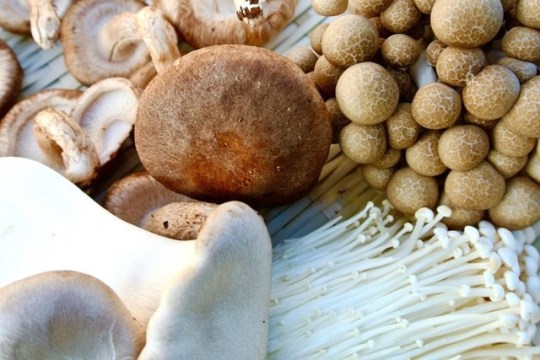
What is Kinoko (mushrooms)?
“Although there are many varieties of edible mushrooms, generally they can be divided into saprobic fungi and mycorrhizal fungi. Saprobic fungi include wood-rotting fungi, which grow out of the trunks of living trees.
Most of the mushrooms that can be cultivated are saprobic fungi; they break down fertilizers and the trees on which they feed. Wood-rotting fungi include shiitake, maitake, nameko, enokidake, buna-shimeji, hiratake, and eringi. White mushrooms and Agaricus do not grow out of trees but are still considered saprobic fungi.”
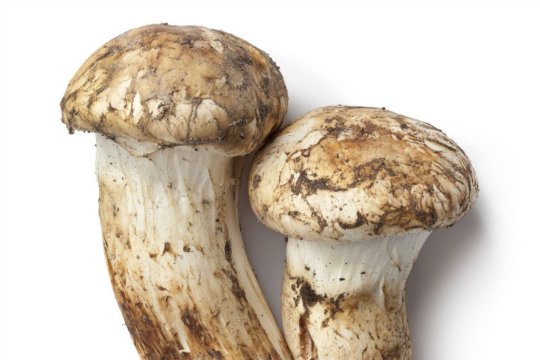
“Matsutake is a mushroom belonging to the class Basidiomycetes. It lives on the roots of Japanese red pine and grows wild on the ground in forests of red pine during autumn...Moreover, matsutake cannot grow unless specific natural conditions are miraculously met. The environment must have just the right sunlight exposure, temperature, humidity, amount of soil microorganisms, and various other conditions.
Kinkatsu refers to a healthy way of eating based on fermented foods Japanese people have long incorporated into their diet many fermented foods produced by microorganisms. The health benefits of these fermented foods have recently garnered attention. Mushrooms are the only fungi that can be consumed as food. They are low in calories and rich in immune-boosting nutrients such as dietary fiber, vitamin Bs, vitamin D, beta-glucan, and ornithine. The dietary fiber in mushrooms can absorb cholesterol and lipids in the intestines and remove them from the body. At the same time, they help create a healthy intestinal environment by increasing good bacteria, which can improve the complexion.”
(via What is Kinoko (mushrooms)? | We Love Japanese Food)
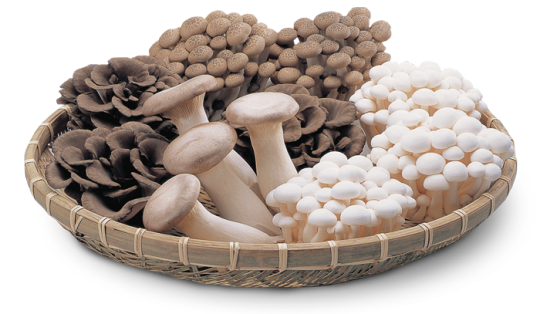
7 Popular Japanese Mushrooms That Are Both Tasty and Healthy
“Japanese mushrooms – the first thing to know is that “take” means “mushroom” in Japanese.”
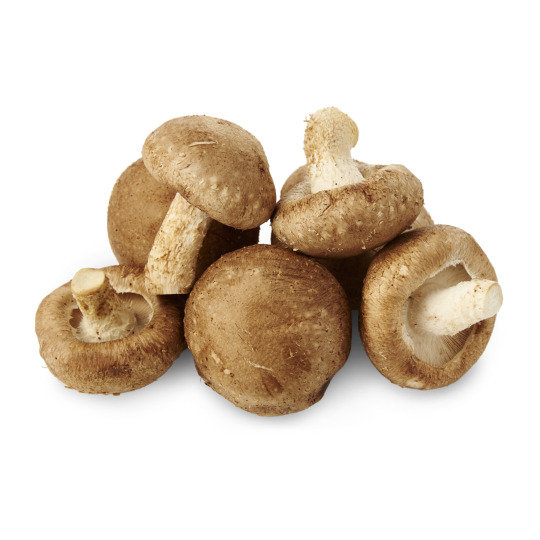
“Shiitake is the one Japanese mushroom that most people will have heard of. “Shii” is the Japanese word for one of the trees this healthy treat grows on. Combined with the Japanese for mushroom, you’ll get the word “shiitake,” or shii mushroom. They are packed with healthy nutrients, have relatively large brown caps, ranging from tan to dark in color, and white stems.”
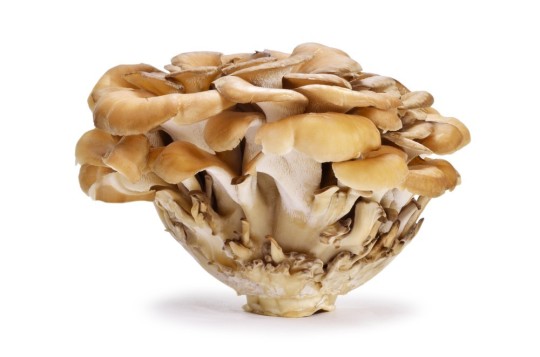
“You might know it as Hen-of-the-wood or even sheep’s head, but in Japan, this funny looking mushroom is called maitake. Literally translating to “dancing mushroom,” this healthy fungal delicacy can be found in Japanese hardwood forests, as well as in parts of China, Europe, and North America.”
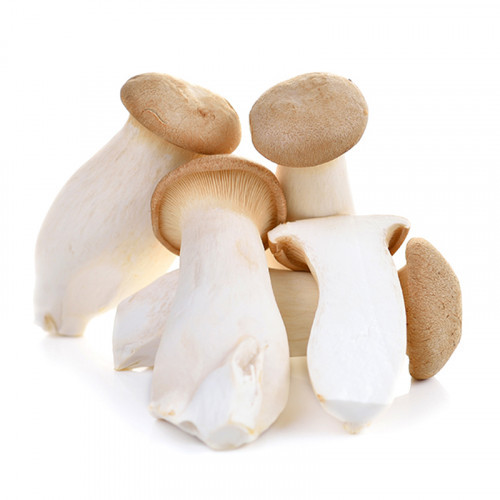
“Eringi, King Trumpet, King Oyster, and French Horn. Eryngii go by many names and are the largest of all oyster mushrooms. It doesn’t only grow in Japan and other parts of Asia, but also in Mediterranean Europe, the Middle East, and North Africa. You can easily recognize it by its characteristic meaty, white stem and relatively small, brown cap.”
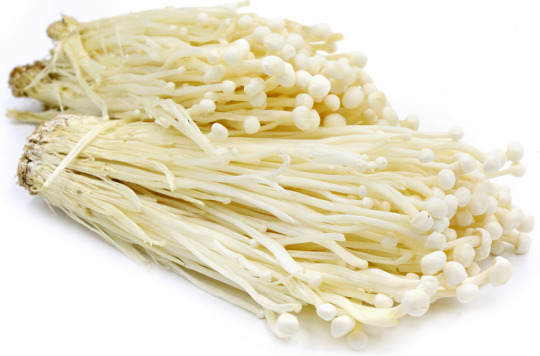
“These little mushroom clusters called enoki or enokitake are thin, long, and fragile, much like little flowers. They’re a well-used ingredient not only in Japanese cuisine but also in Chinese and Korean, and because their main season lasts from September to March, they are sometimes called “winter mushroom” in English.”
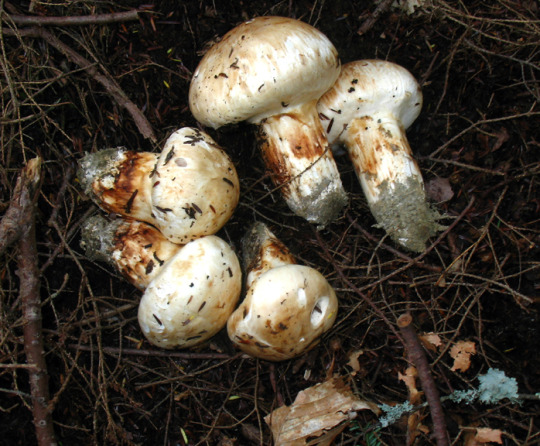
“Mushroom lovers are sure to know matsutake, a prized, sought-after mushroom that is famous for its characteristic spiciness. While it grows in Asia, Europe, and North America, it can prove extremely hard to find, as it requires a very specific kind of forest and terrain to grow. In Japan, they can mainly be found under red pines and the first matsutake harvest in fall can fetch prices of 1,000 dollars or more per kilogram! According to historical documents, matsutake picking was also a favorite pastime of samurai.”

“Nameko is a curious little mushroom. In nature, it appears as a cluster of small mushrooms with orange caps that have a characteristic gelatinous coating. In Japanese pop culture, they’re a fairly famous comic character that first appeared in the DS game “Touch Detective” – you might know the little fellow as “Funghi.” Now, Nameko has his own mobile game called Mushroom Garden.
The mildly nutty taste makes the mushroom a staple ingredient of Japanese cuisineand you’ll often see it used in stir-fries and for noodles...You’ll also encounter nameko as a popular and healthy ingredient in sushi rolls. In the States, this little orange delicacy is also called “butterscotch mushroom.”
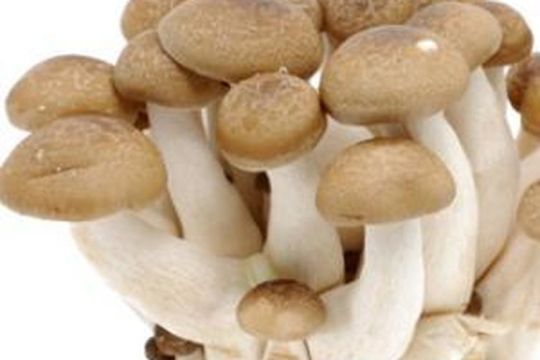
“Found in East Asia and Northern Europe, shimeji is actually a group of mushrooms that come in different shapes and colors. They all have a similar texture and taste, however – while the raw mushrooms are slightly bitter, this unpleasant aroma disappears entirely when cooked, leaving you with a delightfully crunchy texture and mild, nutty flavor. As far as dishes go, shimeji can be used for pretty much anything. From stir-fries to soups, from hot pots to pasta dishes, and even as a side or sauce...”
(via 7 Popular Japanese Mushrooms That Are Both Tasty and Healthy | LIVE JAPAN)

The Shiitake Mushroom- A History in Magic and Folklore
“The shiitake is vastly popular as a dietary choice in China and Japan. In Japan, the creme de la crème of shiitake crop is called donko. In China, it is known as shanku and dongo...Tapestries and Chinese manuscripts depict deities holding several species of medicinal mushroom, including the shiitake, which finds applications in Chinese culture as an aphrodisiac and a promoter of youthfulness and virility.
The Japanese developed a convenient method to cultivate mushrooms. Called the ‘soak and strike’ method, it involved inoculating a tree log with collected spores, and leaving them out in a moist atmosphere. The logs are cut from a tree and placed horizontally, followed by an injection of spores. In fact, this method was synonymous with a development of a male child into a man.”

“Logs inoculated during a child’s birth would mature with him till he attains manhood, and inherit the ‘fortune’ in his backyard. Thus, the shiitake was a prized possession, and people went to the extent of robbing them from one another, leading to what was known as a ‘shiitake war’.
It is clear that the Orient deems mushrooms, in general, as storehouses of the power of healing. As compared to the depiction of the mushroom as a ‘quaint fungus’ in the West, what is known as the ‘Orient’ holds the mushroom in high esteem...Today, the shiitake is grown in several parts of the world. The United States, for instance, cultivates mushroom in several states, including Indiana and Pennsylvania.”
(via The Shiitake Mushroom- A History in Magic and Folklore | goUNESCO)

Chinese History - Southern Dynasties Period Economy
“The first real porcelain was produced in the southern facilities during the time of Eastern Jin. Green glazed porcelain (qingci 青瓷) and imprinted ware (yinwen yingtao 印紋硬陶) with brown dots (jiangseyou caiban 醬色釉彩斑) were produced in the kilns of modern Jiangsu and Zhejiang Prov. Paper (zhi 紙) totally replaced the use of silk and bamboo slips as writing material. Other trade and commercial products of the Southern Dynasties were lacquerware (qiqi 漆器) and tea (cha 茶).”

“Fabric, especially silk, was not only an important item for direct cloth production, but also for tax in kind. For daily use, it was still too expensive to be affordable for the average population. The production of silk was in the hands of the state, like salt production (sea salt in Jiangsu and well salt in Sichuan) and mining and metallurgical engineering.”
(via Chinese History - Southern Dynasties Period Economy | ChinaKnowledge)
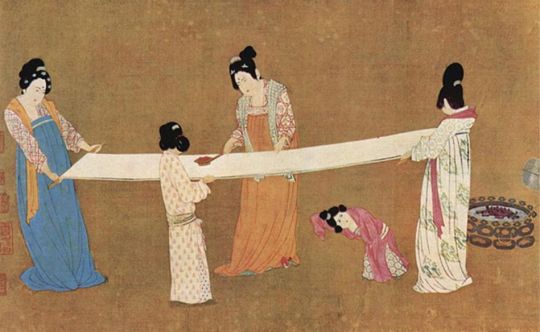
History of silk
“Silk cultivation spread to Japan around 300 AD, and, by 522 AD, the Byzantines managed to obtain silkworm eggs and were able to begin silkworm cultivation. The Arabs also began to manufacture silk at the same time. As a result of the spread of sericulture, Chinese silk exports became less important, although they still maintained dominance over the luxury silk market.”
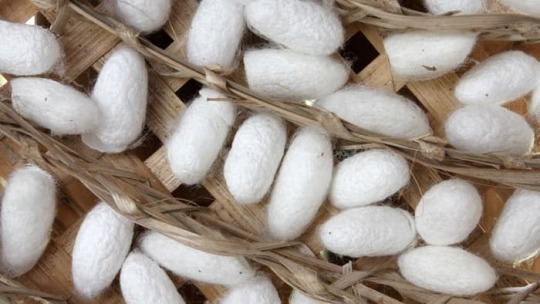
The Crusades brought silk production to Western Europe, in particular to many Italian states, which saw an economic boom exporting silk to the rest of Europe...Techniques of sericulture were subsequently introduced to Japan on a larger scale by frequent diplomatic exchanges between the 8th and 9th centuries.”

”Starting in the 4th century BC silk began to reach the Hellenistic world by merchants who would exchange it for gold, ivory, horses or precious stones. Up to the frontiers of the Roman Empire, silk became a monetary standard for estimating the value of different products.”

“The church manufacture in the Byzantine Empire was thus able to make fabrics for the emperor, with the intention of developing a large silk industry in the Eastern Roman Empire...These gynecia had a legal monopoly on the fabric, but the empire continued to import silk from other major urban centres on the Mediterranean. The magnificence of the Byzantine techniques was not a result of the manufacturing process, but instead of the meticulous attention paid to the execution and decorations. The weaving techniques they used were taken from Egypt.”

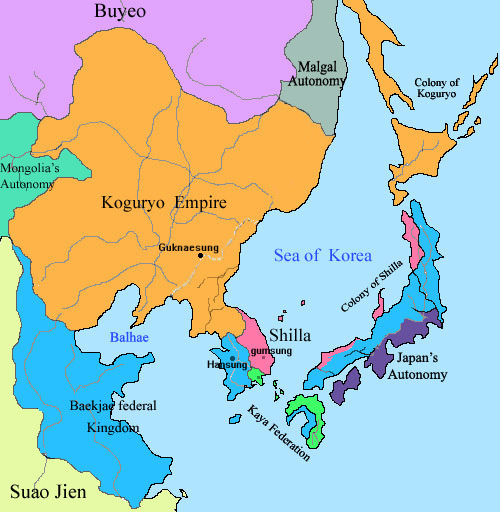
Map 1-1
Japan (500-1200 AD): A Brief Introduction
“During the fifth and sixth centuries, a three-cornered military balance developed on the Korean peninsula between the states of Paekche in the southwest, Silla in the east, and Koguryo in the north (see Map 1-1). Japan was an ally of Paekche and maintained extensive trade and military relations with a weak southern federation known as the Kaya Federation (States). Scholars ask whether there was a cultural basis for these ties—like those of Norman England to Normandy.”
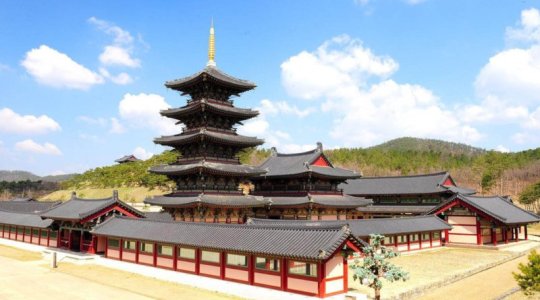
”Paekche also served as a conduit for the first elements of Chinese culture to reach Japan. Chinese writing was adopted for the transcription of Japanese names during the fifth or sixth century. Confucianism entered in 513, when Paekche sent a “scholar of the Five Classics.” Buddhism arrived in 538, when a Paekche king sent a Buddha image, sutras, and possibly a priest.
In 665, Silla conquered Paekche. Japan feared an invasion by Silla, its erstwhile enemy, but an invasion never came. In the end, the rupture of ties with Korea was less of a loss than it would have been earlier, for by this time Japan had established direct relations with China.”
(via The History Of Japan 500-2000 AD | Subratachak blog)
The Kikuchi clan and Baekje
“There are theories that the Kikuchi clan of Higo Province (Kyushu) are from Baekje. They have found a golden statue in the ruins of the castle that is from Baekje and there are records saying that the founder of the Kikuchi, Kikuchi Noritaka (菊池 則隆) is the son of Masanori (政則) and grandson of Chikanori (親則).”

Kikuchi clan
“Japanese genealogist, Suzuki Matoshi claimed the clan was from the Korean kingdom of Baekje while Oota Akira, Japanese historian, claimed the clan originated from Ki clan. Many famous warriors have come from this family such as Kikuchi Takanao, Kikuchi Takefusa who stopped the Mongol Invasions of Japan, Kikuchi Taketoki and Kikuchi Takemitsu whose stories have become some of the most colorful in Japanese history.”
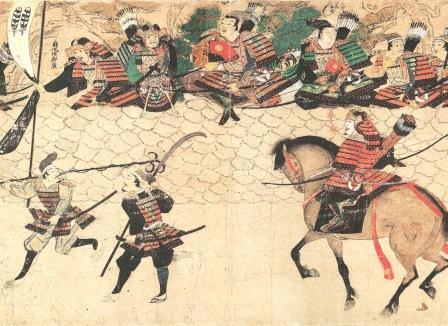
Kija's Tomb
“Jizi allegedly fled China to Korea, where he founded the state of Gija Joseon and eventually succeeded the Dangun as king of Gojoseon. Legend says that Gija brought to the Korean people many skills from China, such as agriculture and weaving; he is also credited with founding the city of Pyongyang.”
”The site of Gija's burial mound was identified during the Goryeo Dynasty by King Sukjong, who constructed the first mausoleum at the 1102. A memorial temple was later added and the mausoleum was enlarged and repaired in 1324 and again in 1355.
In 1570 King Seonjo of Joseon erected a monument at the site requiring all people riding past to dismount out of respect. When Korea was under Japanese rule, the site was heavily promoted as a tourist venue by the Japanese, who tempered Korean ethnic nationalism by pointing out that the first "Korean" kingdom was founded by a foreigner.“
#kinokomushroom#maitake#matsutake#shiitake#nameko#eryngi#kijatomb#kikuchiclan#baekje#greenporcelain#silkhe#kiclan#italiansilk
0 notes
Text
Top 10 Healthiest Mushrooms and Their Benefits
It’s a bird! It’s a plane! It’s a fungi! Superman step aside, because mushrooms are the real heroes. The latest estimates suggest that there are as many as 5.1 million fungal species in the world, but you don’t want to eat most of ’em. So we’ve assembled a team of the best of the best mushrooms. HFR is happy to present “The Super Shroom Squad,” the healthiest mushrooms around.
Here are the Top 10 from Health Fitness Revolution and author of the book ReSYNC Your Life Samir Becic:
Reishi- The Heavy Hitter That Does It All (or almost)
This species of mushroom looks like a big white and brown flower made of wood. It is loaded with ganoderic acid, which is known to help reduce cholesterol and also lower high blood pressure. Reishi, which is known as “Lingzhi” in Chinese, has been revered in Asian societies for thousands of years and is one of the oldest symbols of well-being and longevity, historically only consumed by royalty.
It has strong immune boosting powers and is revered as an antibacterial, antiviral, anti-fungal, anti-cancer fighting fungus. And there’s plenty of research to back up these claims: a 2009 study in Bioorganic & Medicinal Chemistry conducted in Taiwan demonstrated that reishi contained unique polysaccharides that promote longevity by boosting immune system function and preventing abnormal blood vessel formations that could lead to life-threatening cancerous growths.
In 2010, a different study by Pharmacological Reports found that the triterpinoid ganoderic acid found in reishi acted to inhibit the development and metastasis of tumors. A 2011 study expanded on these findings, suggesting that this mushroom could potentially seek out and eradicate existing cancerous cells within the body. More recently, a 2013 study in Food and Chemical Toxicology used the reishi mushroom to reverse chemical-driven liver damage in mice.
Research also suggests that Reishi can help patients with neurodegenerative disorders such as Alzheimers and Huntington’s. Reishi helps fight cancer by supporting the creation of nerve growth factor, a protein that is fundamental for healthy neurological function.
Shiitake – The Tumor Fighter
Not only are these a favorite of Japanese cuisine and an excellent source of Vitamin D, they also contain a natural anti-tumor compound called lentinan. A 2011 study also showed that Shiitake reduces inflammation in the body. The scientists gave 52 healthy adults, age 21 to 41 a four-week supply of dry shiitake mushrooms and told to eat a 4-ounce serving daily. Through blood tests before and after the experiment, researchers saw better-functioning gamma delta T-cells and reductions in inflammatory proteins.
Click the image to see some shiitake mushrooms on Amazon!
Oyster – The One That Helps Fight HIV and Cancer
These fungi which grow readily around the world are rich in protein (30% by dry weight), loaded with B vitamins, are cholesterol free, and have significant levels of the cholesterol-lowering molecule lovastatin. A 2004 study on HIV patients showed that the mushrooms had some anti-retroviral-induced hyperlipidemia.
There seems to be potential benefit from ingesting a tea made from wood grown, freeze dried oyster mushrooms. In the International Journal of Oncology, Jedinaki and Silva (2008) identified two molecular mechanisms from alcohol extracts of oyster mushrooms that “specifically inhibits growth of colon and breast cancer cells without significant effect on normal cells, and has a potential therapeutic/preventive effect on breast and colon cancer.”
Porcini – The Inflammation Fighter
This meaty mushroom is reminiscent to the Portabello and has been shown to be a successful anti-inflammatory. This fungus contains the compound ergosterol which is capable of cytotoxicity which is the process of attacking enemy cells. In a new study on aging, researchers identified which health markers play the most crucial roles in people reaching that magical 100 mark and beyond. More than any other, chronic inflammation surfaced as the most important, changeable factor for both reaching the advanced golden years and enjoying better physical and mental health on the way- so stock up on porcini!
Click the on the image to see some Porcini mushrooms!
White Button- The Prostate Health and Breast Cancer Helper
Button mushrooms — the world’s most commonly eaten mushroom — have grown wild and been eaten by humans since the times of the early hunter-gatherers. Traditional civilizations even knew that mushrooms had special powers. It is said that ancient Egyptians believed mushrooms could grant immortality, and thus only the pharaohs were deemed worthy of eating or even touching them. Modern-day Studies have shown that this popular mushroom that can be found in all grocery stores packs a powerful punch has been shown to be effective in preventing breast and prostate cancer in both animal and human cells.
Maitake – The Blood Sugar Controller
This mushroom species has anticancer, antiviral, and immune-system enhancing effects and may also help control both high blood pressure and blood sugar levels. A particular study found that maitake mushroom extract couple prove highly beneficial to people suffering from insulin resistance and diabetes. In addition, a half of a cup per day of maitake mushrooms is said to be able to sweep the system, find abnormal cells and cause them to self-destruct. Simultaneously, these trumpeting bushels can trigger the body to release immune system cells that attack and kill malignant cells.
Click on the image to see some Maitake mushrooms!
Shimeji – The One that Helps Asthma and Blasts Tumors
This type of mushroom has always been used traditionally in Japan as a defense against asthma. It high potent levels of beta-glucans which suppress allergic reactions- such as recurring asthma. Also, beta-glucans is also known to boost the natural healing capability of the immune system. According to the National Cancer Institute of Japan, this beta-glucan compound is also a successful remedy for retarding and destroying growing tumors.
Chanterelle – The Metabolism Booster
Chanterelle mushrooms have among the highest known natural concentrations of B vitamins, especially vitamins B1, B2, B3, and B5. These vitamins play a fundamental role in converting food into energy and keeping the nervous system healthy. In addition, mushrooms are high in fiber, keeping regular bowel movements and gut health in check. This single mini-trumpet mushroom has been associated with anti-microbial, bacterial and fungal properties in addition to being high in vitamin C, D and potassium.
Click on the image to see some Chanterelle!
Black Truffle – The One that Promotes Bliss
Anyone who is a fan of Italian cooking can instantly recognize the flavor of a truffle and the rush of good feeling associated with tasting its unique flavor. Long used in cooking and touted for its rarity, a new study shows that there’s a reason we’re all going crazy for truffles- they actually contain a “bliss molecule” which is similar to tetrahydrocannabinol, or THC, found in marijuana, and is the chemical responsible for most of marijuana’s mood-enhancing and psychological effects.
Scientists at the University of Rome discovered that the expensive black truffles produce a compound called anandamide, which triggers the discharge of chemicals that enhance the mood, changes appetite, affects memory, and reduces feelings of depression and pain of the human brain. This characteristic of black truffle is also found in marijuana- but without the high! As if we needed another reason to eat truffles!
Chaga – The Antioxidant Power Player
Chaga has been consumed for centuries in the East, usually as tea, where its health benefits are well established. Gaining popularity in the Western hemisphere, one study tested cells that were pre-treated with a chaga mushroom extract, then treated with H202 to induce oxidative stress. The pretreated cells displayed less damage than cells that did not receive the chaga extract.
This particular mushroom species also contains massive amounts of the natural black pigment known as melanin, which has high antioxidant levels from the polyphenols it contains. In fact, chaga has the highest ORAC score (the measure of antioxidant potency) of any superfood. In addition, various studies have shown that chaga can help with diabetes, cardiovascular health, immune health, DNA damage protection, and cholesterol.
[Read More ...]
http://www.healthfitnessrevolution.com/top-10-healthiest-mushrooms-and-their-benefits/
0 notes
Text
Top 10 Healthiest Mushrooms and Their Benefits
http://www.healthfitnessrevolution.com/ws-na.amazon-adsystem.com/widgets/q?_encoding=UTF8&ASIN=B00PXRL3D8&Format=_SL160_&ID=AsinImage&MarketPlace=US&ServiceVersion=20070822&WS=1&tag=healthfit0b4b-20
It’s a bird! It’s a plane! It’s a fungi! Superman step aside, because mushrooms are the real heroes. The latest estimates suggest that there are as many as 5.1 million fungal species in the world, but you don’t want to eat most of ’em. So we’ve assembled a team of the best of the best mushrooms. HFR is happy to present “The Super Shroom Squad,” the healthiest mushrooms around.
Here are the Top 10 from Health Fitness Revolution and author of the book ReSYNC Your Life Samir Becic:
Reishi- The Heavy Hitter That Does It All (or almost)
This species of mushroom looks like a big white and brown flower made of wood. It is loaded with ganoderic acid, which is known to help reduce cholesterol and also lower high blood pressure. Reishi, which is known as “Lingzhi” in Chinese, has been revered in Asian societies for thousands of years and is one of the oldest symbols of well-being and longevity, historically only consumed by royalty.
It has strong immune boosting powers and is revered as an antibacterial, antiviral, anti-fungal, anti-cancer fighting fungus. And there’s plenty of research to back up these claims: a 2009 study in Bioorganic & Medicinal Chemistry conducted in Taiwan demonstrated that reishi contained unique polysaccharides that promote longevity by boosting immune system function and preventing abnormal blood vessel formations that could lead to life-threatening cancerous growths.
In 2010, a different study by Pharmacological Reports found that the triterpinoid ganoderic acid found in reishi acted to inhibit the development and metastasis of tumors. A 2011 study expanded on these findings, suggesting that this mushroom could potentially seek out and eradicate existing cancerous cells within the body. More recently, a 2013 study in Food and Chemical Toxicology used the reishi mushroom to reverse chemical-driven liver damage in mice.
Research also suggests that Reishi can help patients with neurodegenerative disorders such as Alzheimers and Huntington’s. Reishi helps fight cancer by supporting the creation of nerve growth factor, a protein that is fundamental for healthy neurological function.
Shiitake – The Tumor Fighter
Not only are these a favorite of Japanese cuisine and an excellent source of Vitamin D, they also contain a natural anti-tumor compound called lentinan. A 2011 study also showed that Shiitake reduces inflammation in the body. The scientists gave 52 healthy adults, age 21 to 41 a four-week supply of dry shiitake mushrooms and told to eat a 4-ounce serving daily. Through blood tests before and after the experiment, researchers saw better-functioning gamma delta T-cells and reductions in inflammatory proteins.
Click the image to see some shiitake mushrooms on Amazon!
Oyster – The One That Helps Fight HIV and Cancer
These fungi which grow readily around the world are rich in protein (30% by dry weight), loaded with B vitamins, are cholesterol free, and have significant levels of the cholesterol-lowering molecule lovastatin. A 2004 study on HIV patients showed that the mushrooms had some anti-retroviral-induced hyperlipidemia.
There seems to be potential benefit from ingesting a tea made from wood grown, freeze dried oyster mushrooms. In the International Journal of Oncology, Jedinaki and Silva (2008) identified two molecular mechanisms from alcohol extracts of oyster mushrooms that “specifically inhibits growth of colon and breast cancer cells without significant effect on normal cells, and has a potential therapeutic/preventive effect on breast and colon cancer.”
Porcini – The Inflammation Fighter
This meaty mushroom is reminiscent to the Portabello and has been shown to be a successful anti-inflammatory. This fungus contains the compound ergosterol which is capable of cytotoxicity which is the process of attacking enemy cells. In a new study on aging, researchers identified which health markers play the most crucial roles in people reaching that magical 100 mark and beyond. More than any other, chronic inflammation surfaced as the most important, changeable factor for both reaching the advanced golden years and enjoying better physical and mental health on the way- so stock up on porcini!
Click the on the image to see some Porcini mushrooms!
White Button- The Prostate Health and Breast Cancer Helper
Button mushrooms — the world’s most commonly eaten mushroom — have grown wild and been eaten by humans since the times of the early hunter-gatherers. Traditional civilizations even knew that mushrooms had special powers. It is said that ancient Egyptians believed mushrooms could grant immortality, and thus only the pharaohs were deemed worthy of eating or even touching them. Modern-day Studies have shown that this popular mushroom that can be found in all grocery stores packs a powerful punch has been shown to be effective in preventing breast and prostate cancer in both animal and human cells.
Maitake – The Blood Sugar Controller
This mushroom species has anticancer, antiviral, and immune-system enhancing effects and may also help control both high blood pressure and blood sugar levels. A particular study found that maitake mushroom extract couple prove highly beneficial to people suffering from insulin resistance and diabetes. In addition, a half of a cup per day of maitake mushrooms is said to be able to sweep the system, find abnormal cells and cause them to self-destruct. Simultaneously, these trumpeting bushels can trigger the body to release immune system cells that attack and kill malignant cells.
Click on the image to see some Maitake mushrooms!
Shimeji – The One that Helps Asthma and Blasts Tumors
This type of mushroom has always been used traditionally in Japan as a defense against asthma. It high potent levels of beta-glucans which suppress allergic reactions- such as recurring asthma. Also, beta-glucans is also known to boost the natural healing capability of the immune system. According to the National Cancer Institute of Japan, this beta-glucan compound is also a successful remedy for retarding and destroying growing tumors.
Chanterelle – The Metabolism Booster
Chanterelle mushrooms have among the highest known natural concentrations of B vitamins, especially vitamins B1, B2, B3, and B5. These vitamins play a fundamental role in converting food into energy and keeping the nervous system healthy. In addition, mushrooms are high in fiber, keeping regular bowel movements and gut health in check. This single mini-trumpet mushroom has been associated with anti-microbial, bacterial and fungal properties in addition to being high in vitamin C, D and potassium.
Click on the image to see some Chanterelle!
Black Truffle – The One that Promotes Bliss
Anyone who is a fan of Italian cooking can instantly recognize the flavor of a truffle and the rush of good feeling associated with tasting its unique flavor. Long used in cooking and touted for its rarity, a new study shows that there’s a reason we’re all going crazy for truffles- they actually contain a “bliss molecule” which is similar to tetrahydrocannabinol, or THC, found in marijuana, and is the chemical responsible for most of marijuana’s mood-enhancing and psychological effects.
Scientists at the University of Rome discovered that the expensive black truffles produce a compound called anandamide, which triggers the discharge of chemicals that enhance the mood, changes appetite, affects memory, and reduces feelings of depression and pain of the human brain. This characteristic of black truffle is also found in marijuana- but without the high! As if we needed another reason to eat truffles!
Chaga – The Antioxidant Power Player
Chaga has been consumed for centuries in the East, usually as tea, where its health benefits are well established. Gaining popularity in the Western hemisphere, one study tested cells that were pre-treated with a chaga mushroom extract, then treated with H202 to induce oxidative stress. The pretreated cells displayed less damage than cells that did not receive the chaga extract.
This particular mushroom species also contains massive amounts of the natural black pigment known as melanin, which has high antioxidant levels from the polyphenols it contains. In fact, chaga has the highest ORAC score (the measure of antioxidant potency) of any superfood. In addition, various studies have shown that chaga can help with diabetes, cardiovascular health, immune health, DNA damage protection, and cholesterol.
[Read More ...]
http://www.healthfitnessrevolution.com/top-10-healthiest-mushrooms-and-their-benefits/
0 notes
Text
Cook with Vibrancy: Explore Purple Carrots and Shimeji Mushrooms at Fresh Direct
Fresh Direct, the leading online grocery store, offers a delightful culinary experience with its diverse selection of fresh produce. Among the treasures waiting to be discovered are purple carrots and shimeji mushrooms, two colorful ingredients that can elevate your cooking to new heights. With their unique flavors and eye-catching appearances, these vibrant vegetables add a touch of vibrancy and creativity to your dishes. In this article, we will explore the allure of Purple Carrots and shimeji mushrooms, and why FreshDirect is the ideal source to explore and experiment with these delightful ingredients.
The Allure of Purple Carrots:
A Feast for the Eyes: Purple carrots are a visual marvel with their deep purple hues. As you cook them, their color intensifies, creating a stunning and captivating display on your plate. Incorporating purple carrots into your meals can transform an ordinary dish into a work of art.
Nutritional Benefits: Beyond their striking appearance, purple carrots offer numerous health benefits. Their vivid color comes from anthocyanins, potent antioxidants that help combat oxidative stress and inflammation. These antioxidants contribute to improved overall health and well-being.
Sweet and Earthy Flavor: Purple carrots are not only a visual treat but a culinary delight as well. They possess a slightly sweeter and more robust flavor than traditional orange carrots, making them a versatile ingredient for both savory and sweet dishes.
The Versatility of Shimeji Mushrooms:
Unique Texture and Appearance: Shimeji mushrooms are easily recognizable by their petite, thin stems and delicate caps. Available in both white and brown varieties, they add a touch of elegance to any recipe and are sure to impress your taste buds.
Delicate and Savory: When cooked, Shimeji Mushrooms develop a tender and slightly crunchy texture. Their savory taste blends seamlessly with a wide range of ingredients, making them a versatile addition to soups, stir-fries, and more.
Rich in Nutrients: Shimeji mushrooms are not just delightful to the palate but also nutritious. They contain essential nutrients like B-vitamins, copper, and selenium, which support your overall health and well-being.
Fresh Direct: A Destination for Quality Produce
Fresh Direct prides itself on offering the freshest and highest-quality produce to its customers. With a convenient online platform, you can easily explore their wide array of products, including purple carrots and shimeji mushrooms. With a simple click, these vibrant ingredients will be delivered directly to your doorstep, ensuring a seamless and enjoyable shopping experience.
Culinary Inspirations:
Roasted Purple Carrots with Honey Glaze: Roast purple carrots in the oven with a drizzle of honey and olive oil, and sprinkle with fresh herbs for a sweet and savory side dish that compliments any main course.
Shimeji Mushroom and Vegetable Stir-Fry: Create a colorful and nutritious stir-fry by sautéing shimeji mushrooms with an assortment of vibrant vegetables in a savory sauce.
Rainbow Vegetable Salad: Combine purple carrots, shimeji mushrooms, and a medley of other colorful vegetables in a fresh salad. Drizzle with a zesty vinaigrette for a burst of flavor.
Conclusion:
Fresh Direct offers a delightful culinary journey with its selection of purple carrots and shimeji mushrooms. Incorporating these vibrant ingredients into your cooking not only adds a feast for the eyes but also introduces unique flavors and nutritional benefits. Whether you're a seasoned chef or a passionate home cook, fresh direct assortment of produce, including purple carrots and shimeji mushrooms, is sure to inspire creativity in your kitchen. Embark on a journey of vibrancy and flavor today by exploring these delightful ingredients at Fresh Direct. Happy cooking!

0 notes
Photo

#vegbubble#Edible mushrooms#mushroomcultivation#best mushroom in india#buna shimeji mushrooms#shimeji mushrooms#Buna shimeji mushroom health benefits
0 notes
Text
Beta Glucan Market - Global Industry Insights, Trends, Outlook, and Opportunity Analysis, 2018-2025
Beta Glucan Market Outlook
Europe is estimated to contribute to the largest share in the global beta glucan market. Major factors driving growth of this market include rising demand for functional foods. According to Government of South Australia, the global functional food market was estimated at US$ 160 bn and Europe accounted for 30% of global functional food sales in 2015. Furthermore increasing research and development spending in the pharmaceutical industry is also expected to boost growth of the beta glucan For instance, according to the EFPIA, in 2015, the total investment in research and development activities in the European pharmaceutical industry, was valued at US$ 41.53 Bn. Additionally, increasing approval of various health claims pertaining to the consumption of beta glucan by government organizations such as European Food Safety Authority and Food and Drug Administration(FDA) is expected to increase the demand for beta glucan. For instance, in 2009, European Food Safety Authority approved that the regular consumption of beta glucans helps maintain normal blood cholesterol concentrations. This in turn, is supporting the overall growth of beta glucan market.
Ask for detailed Sample of the Research Report@ https://www.coherentmarketinsights.com/insight/request-sample/1428
*The Sample consists of Table of Content, Research framework of the actual report & research methodology adopted for it.
Asia Pacific is expected to record the fastest growth in the global beta glucan Major factors supporting growth of the market in the region include rising awareness regarding the health benefits of beta glucan among the populace and the steadily growing demand for nutraceutical ingredients. Beta glucan is widely used as a nutraceutical ingredient in protein bars, teas, fruit juices, and smoothies. According to the Coherent Market Insights, in 2016, Asia Pacific held a dominant position in the global nutraceutical ingredients market, with 36.19% market share. Furthermore, beta glucan is used to enhance immunity for those with a weakened body defense system due to treatments such as chemotherapy or radiation. Additionally, it is also used to control the blood sugar and it increases the synthesis of glycogen, in order to control obesity. Thus, the growing prevalence of obesity and diabetes in the region is fuelling the demand for beta glucan. According to the World Health Organization (WHO), 96 million adults, in South-East Asia and 131 million adults in Western Pacific region, were reported with diabetes in 2014.
Beta glucans are natural polysaccharides, majorly found in whole grains such as oats and barley as well as in a variety of mushrooms such as maitake, shiitake, shimeji, and reishi. It is also found in the cell walls of yeast, fungi, algae, and bacteria. Beta glucans are useful in the treatment of cancer, HIV/AIDS, diabetes, high cholesterol, H1N1 (swine flu), hepatitis, asthma, and arthritis. It is also used to the skin for eczema, dermatitis, wounds, wrinkles, burns, and diabetic ulcers. Additionally, beta glucans are extensive used as a fat substitute, immunomodulator, and yeast additive in biodiesel production. The growing demand for beta glucans in the pharmaceutical industry, owing to its medicinal properties, is a major factor, boosting growth of the beta glucans market. However, the instability in the price of beta glucan may negatively affect the market growth.
Among application, the pharmaceuticals segment is estimated to account for the largest share in 2017. The dominance of the segment is majorly attributed to its extensive application in the treatment of various diseases such as cancer, diabetes, asthma, and hepatitis. Furthermore, the food and beverages segment is expected to record the fastest growth during the forecast period (2017 – 2025). Rising consumer awareness regarding the benefits of fiber intake such as controlling sugar and cholesterol level in body coupled with the growing demand for fiber fortified beverages, including fruit smoothies, powdered drink mixes and dairy-alternative drinks, is fuelling the demand for beta glucan in the food and beverages industry.
Market players in the global beta glucan market are adopting various strategies such as merger and acquisitions and product development to strengthen their foothold in the global market. For instance, in December 2012, Koninklijke DSM N.V. added oat beta glucan under the brand name OatWell to their ingredient portfolio and in May 2013, Tate and Lyle Plc. acquired Biovelop International AB, a manufacturing company of oat beta glucan.
To get detailed table of content (ToC)@ https://www.coherentmarketinsights.com/ongoing-insight/toc/1428
Leading players operating in the global beta glucan market include Tate and Lyle Plc., Koninklijke DSM N.V., Biotec Pharmacon ASA Ltd., Lallemand Inc., Specialty Biotech Co., Cargill Inc., Bio Springer S.A., Associated British Foods Plc., Garuda International Inc., and Angel Yeast Co. Ltd.
Beta Glucan Market Taxonomy
On the basis of source, beta glucan market is segmented into:
Cereal
Oats
Barley
Yeast
Seaweed
Mushroom
Others
On the basis of end-use industry, beta glucan market is segmented into:
Food & Beverages
Pharmaceuticals
Animal Feed
Personal Care
Others
About Coherent Market Insights:
Coherent Market Insights is a prominent market research and consulting firm offering action-ready syndicated research reports, custom market analysis, consulting services, and competitive analysis through various recommendations related to emerging market trends, technologies, and potential absolute dollar opportunity.
Contact Us
Mr. Shah
Coherent Market Insights
1001 4th Ave,
#3200
Seattle, WA 98154
Tel: +1-206-701-6702
Email: [email protected]
0 notes